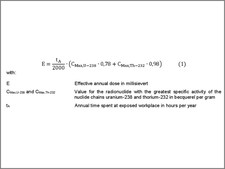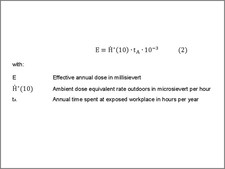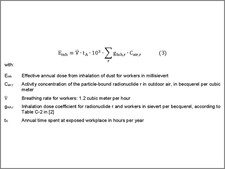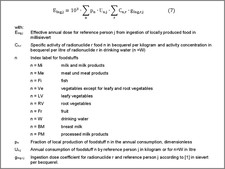-
Topics
subnavigation
Topics
Electromagnetic fields
- What are electromagnetic fields?
- Static and low-frequency fields
- Radiation protection relating to the expansion of the national grid
- High-frequency fields
- Radiation protection in mobile communication
Optical radiation
Ionising radiation
- What is ionising radiation?
- Radioactivity in the environment
- Applications in medicine
- Applications in daily life and in technology
- Effects
- What are the effects of radiation?
- Effects of selected radioactive materials
- Consequences of a radiation accident
- Cancer and leukaemia
- Genetic radiation effects
- Individual radiosensitivity
- Epidemiology of radiation-induced diseases
- Ionising radiation: positive effects?
- Risk estimation and assessment
- Radiation protection
- Nuclear accident management
- Service offers
-
The BfS
subnavigation
The BfS
- About us
- Science and research
- Laws and regulations
- BfS Topics in the Bundestag
- Links
Simplified dose estimation
- When dealing with NORM, workers within a factory where these residues arise, and also those outside - at recycling or disposal facilities - can be subject to increased radiation exposure.
- Even the general public can be affected by increased radiation exposure from recycling or disposal.
- How can this radiation exposure be estimated in a simplified manner and how can it if applicable be reduced?
In order to estimate radiation exposure from mining-related environmental radioactivity, the Federal Office for Radiation Protection (BfS) has made available its "Calculation Guide for the Determination of Radiation Exposure due to Environmental Radioactivity Resulting from Mining (Calculation Guide Mining)"
[1]. Comparable calculation guides are currently being compiled on the subject of "residues with enhanced natural radioactivity"
("Naturally Occurring Radioactive Materials"
, "NORM"
for short). The recommendations listed hereafter for the simplified dose estimation do not replace the planned calculation guides NORM. The calculation specifications listed are compiled far more from reports published to date on the estimation of radiation exposure [1], [2].
In Part 3 of the Radiation Protection Ordinance (Appendix XI), fields of work are listed where workers can be subject to radiation exposure from natural radionuclides of over one millisievert per year [3]. For the workplaces mentioned there, it is mandatory that a dose estimation is carried out to find whether reference value of the effective dose of six millisieverts is exceeded.
Furthermore, workers in other fields of work dealing with NORM (for example residues according to Radiation Protection Ordinance Appendix XII) can be subject to increased radiation exposure. The assessment of whether increased radiation exposure occurs is made in these cases using a reference value for the effective dose of one millisievert per year. This stricter value also applies to the general population. If workers come into contact with NORM at several places of work, the effective dose at all exposed workplaces is to be calculated individually. The sum of the effective doses then decides the overall rating.
The classification into reference values for the effective of one and/or six millisieverts is oriented here towards the categorisation of persons exposed to radiation occupationally (Paragraph 54 of the Radiation Protection Ordinance).
Occupational radiation exposure
Estimation of radiation exposure from specific activity
The radiation exposure of workers can in principle be determined from the specific activity of residues with the help of models. For this, the Federal Office for Radiation Protection has published a simplified calculation specification to calculate the effective annual dose [2]. The model considers
- the external radiation exposure due to a stay in immediate proximity to a large quantity of heaped material,
- the inhalation of dust with a dust concentration of 10 milligrams per cubic metre and
- the unintentional ingestion of 6 milligrams of dust per working hour.
In addition, it is assumed that uranium-238 and uranium-235 are present in the natural isotopic ratio and these radionuclides, as well as thorium-232 are in radioactive equilibrium with their decay products. If the radioactive equilibrium is disturbed in residues, the highest specific activity within the uranium-238 and thorium-232 decay chains are used for a conservative dose estimation. According to [2], the effective annual dose E in millisievert can be calculated using the equation 1:
If in the result the value for E is larger than 1 millisievert, there is not necessarily any increased radiation exposure for workers. In this case, a detailed exposure estimation should be carried out across all exposure pathways using realistic parameters (for example nuclide ratios, dust concentration in the air, stay times).
Estimation of radiation exposure through external gamma radiation
Radiation exposure to external gamma radiation can be determined directly using a personal dose meter. Measurement offices offer these devices and evaluate the results of the measurements. Another possibility for determing radiation exposure from external gamma radiation is to measure the ambient dose equivalent rate H*(10) (here: ambient dose rate per unit of time) with suitable measurement instruments and to ascertain the actual time spent at the exposed workplace. The Physikalisch-Technische Bundesanstalt (National Metrology Institute of Germany / PTB) publishes on its website the designations of all devices with type approval (prerequisite for calibratability).
Using equation 2, the annual effective dose E in millisievert can be calculated from the measured ambient dose equivalent rate [1].
Estimation of radiation exposure through inhalation of dust
The exposure pathway “inhalation of dust” is only taken into consideration when dealing with or working in the vicinity of dry residues. The possibility of dust build-up is negligible with wet residues.
In some residues, radionuclides are unequally distributed throughout the residue. So for example in the filter gravel from water treatment, the radionuclide content in the crusts is several times greater than in the overall residue. In such cases, the radionuclide content in the dust must be determined separately. An exposure estimation for radiological assessment of NORM is generally carried out nuclide specific. The annual effective dose is then estimated with the help of the equation 3.
A good approximation of the activity concentration in the breathable air (in becquerels per cubic metre) can be determined from the dust concentration (in grams per cubic metre) and from the radionuclide content of the material (in becquerels per gram). To determine the dust concentration, institutions like the Berufsgenossenschaftliche Institut für Arbeitssicherheit [German Institute for Industrial Safety (BIA)] recommend suitable measurement methods.
Estimation of radiation exposure through inhalation of radon and its decay products
Primarily in poorly ventilated workplaces in buildings, workers are frequently subject to radiation exposure through the inhalation of radon-222 and its short-lived decay products. The parameter crucial to the dose is the potential alpha energy exposure (time integral of the potential alpha energy concentration). Alternatively, the effective dose can be estimated from the values of radon-222 concentration, the equilibrium factor and the time spent at exposed workplaces (see [2] for a list of suitable procedures).
The annual effective dose can be estimated according to [1] as well as on the basis of the potential alpha energy exposure of short-lived radon-222 decay products (equation 4) and also the radon-222 exposure and the equilibrium factor (equation 5):
Estimation of radiation exposure through direct ingestion of NORM
The exposure pathway “direct ingestion” takes into account the unintentional ingestion of dust from NORM during working hours. In principle, the exposure estimation is carried out nuclide specifically. The calculation of the annual effective dose is then made according to [1] using the equation 6.
Radiation exposure of the general public
In the recycling of NORM, members of the general public can also be subject to additional radiation exposure. The exposure pathways listed for occupational exposure
- inhalation of dust,
- inhalation of radon,
- unintentional direct ingestion of NORM and
- external exposure to gamma radiation
are also to be considered when estimating the radiation exposure of the general public.
Age-dependent parameters are however to be applied to some exposure pathways (see "Calculation Guide Mining"
[1]). In addition, the so-called water pathway can be significant for the general public. This must always be considered when recycling or disposing of residues, where radionuclides can be released from the residue by rainwater and flow into the groundwater with the seepage water. An example of this is recycling in landscaping projects.
If water from a (private) well from the affected aquifer is to be used for drinking water purposes or for the irrigation of locally produced food (vegetable, fruit or even meadow lands), it can lead in unfavourable conditions to greater exposure for the general population than for the workers.
Estimation of radiation exposure through ingestion of locally produced food
In the exposure scenario “ingestion of locally produced food”, it is assumed that all of the necessary drinking water comes from a domestic well, which is situated 20 metres away from a NORM deposit. In addition, plants and animals for domestic consumption are supplied with this water. Furthermore, this model presumes that half of all food consumed is produced locally. The “Calculation Guide Mining” [1] describes in detail how radiation exposure from locally produced food is calculated. The equation 7 shows which foods can contribute to the overall dose:
For an initial assessment, laboratory tests can help whether relevant radiation exposure may occur via the water pathway by calculating the likely release rate of radionuclides from NORM into water. With reference to current developments in soil protection law, a standardised test procedure (for example DIN 19529) is to be used for this [4]. The water-to-solid ratio should if possible be 2:1.
In terms of radiation protection, the unfavourable point of exposure is the well for groundwater removal from a usable aquifer. Therefore, a dilution of the dissolved radionuclides in the seepage water entering the groundwater must be considered. For an initial assessment, the activity concentration ascertained by the laboratory test can therefore be used as an upper value for the well water concentration.
Radiation protection measures
Occupational radiation protection
According to the "ALARA principle", radiation exposure for workers is to be kept as low as possible, as far as is it reasonable. When working with NORM - regarding current provisions for occupational safety - radiation exposure through the inhalation of dust and the unintentional ingestion of contaminated material can be avoided almost entirely.
The equations (1) to (6) show that the annual effective dose depends linearly on the relevant parameters, such as the specific activity of the residue, the dust concentration or the time spent at the exposed workplace. Radiation exposure for workers can therefore be reduced by the following arrangements:
- Recycling of residues with the lowest possible specific activity,
- Identifying primary sources of dust development, checking the effectiveness of protection facilities and if necessary implementing arrangements for the avoidance of dust release,
- Checking and optimising work times at exposed work places,
- Using individual protection equipment.
The extent to which individual arrangements can be implemented depends of course on each particular operational situation.
Assessment of radiation exposure of the general public
If there are no concerns that the sum of all exposure pathways, including the water pathway, will exceed the reference value for the effective dose of 1 millisievert per year, then recycling and/or disposal can be effected in the planned way.
If the result of the simplified dose estimation indicates that the reference value for the effective dose has been exceeded, it does not necessarily indicate that there has been an impermissible exposure. In this case, a site specific exposure estimation has to be performed gaining more precise information. For example, for the water pathway a detailed investigation into radionuclide transportation in seepage and groundwater is recommended. Resource material is published by the BfS in its article "Guidelines on the investigation and assessment of mining legacies"
[5].
If the result from the site specific exposure assessment again exceeds the dose guideline of 1 millisievert per year as a total of all exposure pathways, recycling in the planned way is not possible. In this case, other recycling or disposal possibilities must be tested.
Bibliography:
[1] BfS (2010): BfS (2011) Calculation Guide for the Determination of Radiation Exposure due to Environmental Radioactivity Resulting from Mining (Calculation Guide Mining)
[2] Beck, T., Ettenhuber, E. (2006): Überwachung von Strahlenexpositionen bei Arbeiten Leitfaden für die Umsetzung der Regelungen nach Teil 3 Kapitel 1 und 2 der StrlSchV, BfS-SW-03/06, ISSN 1611-8723 (Monitoring of radiation exposure at work Guidelines for the implementation of regulations under Part 3 Chapters 1 and 2 of the StrlSchV], BfS-SW-03/06, ISSN 1611-8723, in German)
[3] StrlSchV (2001): Ordinance for on the Protection against Damage and Injuries Caused by Ionising Radiation
Note: After a transitional period Radiation Protection Ordinance (StrlSchV) will be replaced by the Radiation Protection Act (StrlSchG) which entered into force in July 2017.
[4] DIN 19529:2009-01:Titel: Elution von Feststoffen - Schüttelverfahren zur Untersuchung des Elutionsverhaltens von anorganischen Stoffen mit einem Wasser/Feststoff-Verhältnis von 2 l/kg (Elution of solids - batch experiments to investigate the elution behaviour of inorganic materials with a water/solid ratio of 2 l/kg.] Beuth-Verlag, Berlin, in German). Beuth-Verlag, Berlin
[5] Leitfaden des Bundesamtes für Strahlenschutz zur Untersuchung und Bewertung bergbaulicher Altlasten (Guidelines from the Federal Office for Radiation Protection on the investigation and assessment of mining residues, in German)
State of 2018.04.12








